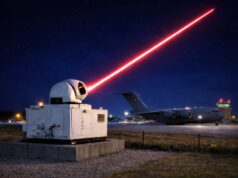The Queen Elizabeth University Hospital (QEUH) in Glasgow has completed a major upgrade of its rooftop helipad, ensuring the continued safe transfer of critically ill and injured patients.
The project, funded with a donation of over £180,000 from the HELP Appeal charity, represents a significant enhancement to one of Scotland’s busiest helipads.
The work involved the installation of a high-friction surface, enabling safer landings in all but the most severe weather conditions. Additionally, the hospital’s name identifier on the helipad was updated from Southern General Hospital to QEU HOSPITAL, reflecting the facility’s renaming following its opening by Queen Elizabeth II in 2015.
Euan Smith, Sector Estates Manager at NHS Greater Glasgow and Clyde (NHSGGC), explained the helipad’s critical role:
“The Queen Elizabeth University Hospital is a nationally important centre caring for some of the sickest and most seriously injured patients from throughout the country. The helipad is critical to this care, accepting patients ranging from major trauma cases to highly complex maternity cases from remote areas of the country.”
The QEUH helipad has facilitated over 2,700 landings since its inauguration, making it one of the busiest in the UK. In 2022, its pivotal role was highlighted in the Channel 4 documentary Rescue: Extreme Medics, which showcased the work of the Scottish Trauma Network in responding to emergencies across the region.
Simon Jones, Helipad Technical Lead at the HELP Appeal, joined NHSGGC staff to mark the completion of the project. Looking ahead, NHSGGC plans a second phase of upgrades in 2024, which will include the addition of high-quality lighting to improve visibility for helicopter crews. This phase will also be funded by the HELP Appeal.
Robert Bertram, Chief Executive of the HELP Appeal, emphasised the charity’s commitment to supporting life-saving infrastructure:
“We are proud to support this helipad, which has facilitated over 2,700 landings since its opening, making it one of the busiest in the country. We were eager to ensure it continues to operate at the highest standards, providing the capability to receive air ambulances carrying critically ill patients at any hour – day or night – so they can access urgent care in the Emergency Department without delay.”














Amazing how much good work the charity sector does for critical care with Air Ambulance. For example the Air Ambulance helicopter and expert crews are not NHS funded, rather separate charities. Ground Ambulance for less urgent care are NHS funded, which seems like an historical anomaly..
Helipad are vital infrastructure because they route critical patients to ICU and Operating Theatre for life saving intervention. So the helipad lift goes directly to ICU or Theatre as required with minimal physical delay having called ahead to the Hospital trauma team. The critical first hour post trauma therefore has the best action for patient survival.
Back in the day, when I was severely injured in a road traffic incident the Air Ambulance took me to King’s College Hospital (Dollis Hill) however in the absence of a helipad had to land in the nearest park and put me in a ground ambulance for the last half mile to Theatre.
Since then the charity donations have built a helipad to minimise delay and improve patient outcomes. Thanks to all the donors and NHS staff who made that happen.
Well said.
I support the Surrey Air Ambulance on a monthly basis.
In Scotland we have a mix of publicly (2 rotary, 2 fixed wing) & charitably funded air ambulances (2 rotary). & not to forget the work of the Coastguard helicopters which are regular visitors to QEUH.